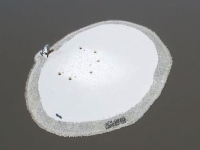 Malheur NWR consists of more than 185,000 acres of wetland habitat in the high desert of southeastern Oregon near the town of Burns, and is owned and managed by the U.S. Fish and Wildlife Service. The refuge is located on the Pacific Flyway and is home to a variety of migratory waterfowl, shorebirds, and colonial waterbirds, including Caspian terns. Malheur NWR is a historical breeding area for Caspian terns, but tern nesting in the Refuge has been erratic due to highly variable lake levels and the associated island erosion/inundation and land-bridging. In 2011, a high water year, about 150 breeding pairs of Caspian terns attempted to nest on a small island located on the Singhus Ranch along the northern edge of Malheur Lake, private property immediately adjacent to the Refuge. Few Caspian terns successfully raised young on this island in 2011.
Malheur NWR consists of more than 185,000 acres of wetland habitat in the high desert of southeastern Oregon near the town of Burns, and is owned and managed by the U.S. Fish and Wildlife Service. The refuge is located on the Pacific Flyway and is home to a variety of migratory waterfowl, shorebirds, and colonial waterbirds, including Caspian terns. Malheur NWR is a historical breeding area for Caspian terns, but tern nesting in the Refuge has been erratic due to highly variable lake levels and the associated island erosion/inundation and land-bridging. In 2011, a high water year, about 150 breeding pairs of Caspian terns attempted to nest on a small island located on the Singhus Ranch along the northern edge of Malheur Lake, private property immediately adjacent to the Refuge. Few Caspian terns successfully raised young on this island in 2011.
In February 2012, the U.S. Army Corps of Engineers, in partnership with the U.S. Fish and Wildlife Service, completed construction a 1-acre rock-core island located within the Refuge in the south-central part of Malheur Lake. This new island was intended to provide nesting habitat for Caspian terns and other colonial waterbirds at the Malheur NWR. Caspian tern decoys and audio systems that broadcast Caspian tern calls have been installed on the Malheur Lake tern island in an effort to attract terns to nest at the site. Malheur NWR is one of six sites in interior Oregon and California where resource managers have built islands to provide alternative nesting habitat for Caspian terns currently nesting at the large colony on East Sand Island in the Columbia River estuary.



